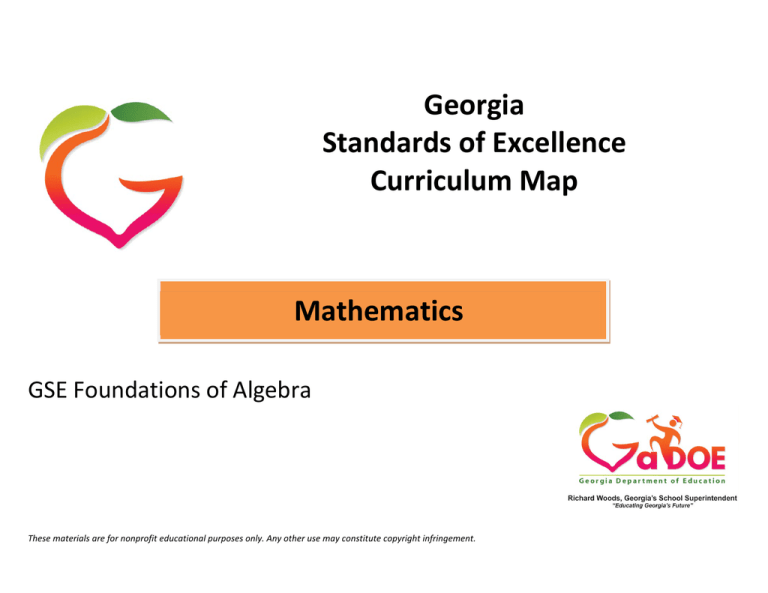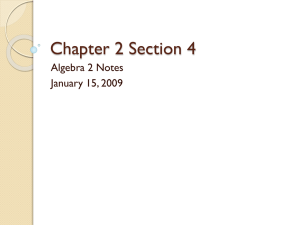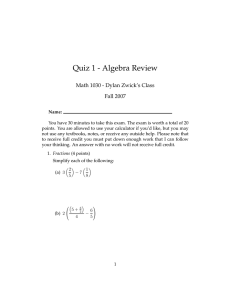
Georgia
Standards of Excellence
Curriculum Map
Mathematics
GSE Foundations of Algebra
These materials are for nonprofit educational purposes only. Any other use may constitute copyright infringement.
Georgia Department of Education
Georgia Standards of Excellence Foundations of Algebra Curriculum Map
1st Semester
Module 1
Number Sense and Quantity
MFANSQ1
MFANSQ2
MFANSQ3
MFANSQ4
Module 2
2nd Semester
Module 3
Arithmetic to Algebra Proportional Reasoning
MFAAA1
MFAAA2
Module 4
Module 5
Equations and Inequalities
Quantitative Reasoning with
Functions
MFAEI1
MFAEI2
MFAEI3
MFAEI4
MFAQR1
MFAQR2
MFAQR3
MFAPR1
MFAPR2
MFAPR3
All units will include the Mathematical Practices and indicate skills to maintain.
NOTE: Mathematical standards are interwoven and should be addressed throughout the year in as many different modules and tasks as possible in order to stress the natural connections that exist among mathematical topics.
Foundations of Algebra Key:
NSQ = Number Sense and Quantity
AA = Arithmetic to Algebra
PR = Proportional Reasoning
EI = Equations and Inequalities
QR = Quantitative Reasoning with Functions
Richard Woods, State School Superintendent
July 2015 ● Page 2 of 6
All Rights Reserved
Georgia Department of Education
Georgia Standards of Excellence Foundations of Algebra
Curriculum Map Rationale
Module 1: This module focuses on building a conceptual understanding of basic mathematical ideas which will enhance the student’s number sense,
rather than a focus on algorithms. The unit begins with the use of whole numbers followed by fractions, decimals, and integers through the lens of
problem solving. Students will use a variety of strategies and manipulative tools.
Module 2: This module focuses on the creation of a connection between arithmetic skills and operations in algebra. Students will draw conclusions
from computation with specific numbers in order to build generalizations about properties that can be used for numbers and variables. Students will
interpret and apply the properties of exponents and use concrete models to investigate square roots and cube roots. The module lays the groundwork
for modules 3, 4, and 5.
Module 3: This module focuses on the use of modeling to explain equivalent ratios and to understand real-world rate, ratio, and percentage problems.
Students will derive slope using similar triangles and interpret slope using unit rates.
Module 4: This module focuses on building understanding of concepts of variables, equations, and inequalities. Systems of equations, solutions of
equations, and inequalities will be interpreted in relationship to real-world applications. Multi-variable formulas will be solved for specific variables
using algebraic operations.
Module 5: This module focuses on functions and the characteristics of functions such as domain, range, and rates of change. The y-intercept form of
linear functions will be used to graph lines and to compare the rates of change of functions.
Richard Woods, State School Superintendent
July 2015 ● Page 3 of 6
All Rights Reserved
Georgia Department of Education
Georgia Standards of Excellence Foundations of Algebra Expanded Curriculum Map – 1st Semester
Standards for Mathematical Practice
5 Use appropriate tools strategically.
6 Attend to precision.
7 Look for and make use of structure.
8 Look for and express regularity in repeated reasoning.
1st Semester
1 Make sense of problems and persevere in solving them.
2 Reason abstractly and quantitatively.
3 Construct viable arguments and critique the reasoning of others.
4 Model with mathematics.
Module 1
Number Sense and Quantity
Students will compare different representations of numbers
(i.e. fractions, decimals, radicals, etc.) and perform basic
operations using these different representations.
MFANSQ1. Students will analyze number relationships.
a. Solve multi-step real world problems, analyzing the
relationships between all four operations. For example,
understand division as an unknown-factor problem in
order to solve problems. Knowing that 50 x 40 = 2000
helps students determine how many boxes of cupcakes
they will need in order to ship 2000 cupcakes in boxes
that hold 40 cupcakes each. (MGSE3.OA.6,
MGSE4.OA.3)
b. Understand a fraction a/b as a multiple of 1/b.
(MGSE4.NF.4)
c. Explain patterns in the placement of decimal points when
multiplying or dividing by powers of ten.
(MGSE5.NBT.2)
d. Compare fractions and decimals to the thousandths place.
For fractions, use strategies other than cross
multiplication. For example, locating the fractions on a
number line or using benchmark fractions to reason about
relative size. For decimals, use place value.
(MGSE4.NF.2;MGSE5.NBT.3,4)
MFANSQ2. Students will conceptualize positive and
negative numbers (including decimals and fractions).
a. Explain the meaning of zero. (MGSE6.NS.5)
b. Represent numbers on a number line. (MGSE6.NS.5,6)
c. Explain meanings of real numbers in a real world context.
(MGSE6.NS.5)
MFANSQ3. Students will recognize that there are numbers
that are not rational, and approximate them with rational
numbers.
a. Find an estimated decimal expansion of an irrational
number locating the approximations on a number line.
For example, for the √2, show that the √2 is between 1
and 2, then between 1.4 and 1.5, and explain how to
continue this pattern in order to obtain better
Module 2
Module 3
Arithmetic to Algebra
Proportional Reasoning
Students will extend arithmetic operations to algebraic
modeling.
MFAAA1. Students will generate and interpret equivalent
numeric and algebraic expressions.
a. Apply properties of operations emphasizing when the
commutative property applies. (MGSE7.EE.1)
b. Use area models to represent the distributive property
and develop understandings of addition and
multiplication (all positive rational numbers should be
included in the models). (MGSE3.MD.7)
c. Model numerical expressions (arrays) leading to the
modeling of algebraic expressions. (MGSE7.EE.1,2;
MGSE9-12.A.SSE.1,3)
d. Add, subtract, and multiply algebraic expressions.
(MGSE6.EE.3, MGSE6.EE.4, MC7.EE.1, MGSE912.A.SSE.3)
e. Generate equivalent expressions using properties of
operations and understand various representations within
context. For example, distinguish multiplicative
comparison from additive comparison. Students should
be able to explain the difference between “3 more” and
“3 times”. (MGSE4.0A.2; MGSE6.EE.3, MGSE7.EE.1,
2, MGSE9-12.A.SSE.3)
f. Evaluate formulas at specific values for variables. For
example, use formulas such as A = l x w and find the
area given the values for the length and width.
(MGSE6.EE.2)
MFAAA2. Students will interpret and use the properties of
exponents.
a. Substitute numeric values into formulas containing
exponents, interpreting units consistently. (MGSE6.EE.2,
MGSE9-12.N.Q.1, MGSE9-12.A.SSE.1, MGSE912.N.RN.2)
b. Use properties of integer exponents to find equivalent
1
numerical expressions. For example, 32 x 3 -5 = 3 -3 = 3
Students will use ratios to solve real-world and mathematical
problems.
MFAPR1. Students will explain equivalent ratios by using
a variety of models. For example, tables of values, tape
diagrams, bar models, double number line diagrams, and
equations. (MGSE6.RP.3)
MFAPR2. Students will recognize and represent
proportional relationships between quantities.
a. Relate proportionality to fraction equivalence and
3
4
division. For example, is equal to because both yield
6
8
a quotient of ½ and, in both cases, the denominator is
double the value of the numerator. (MGSE4.NF.1)
b. Understand real-world rate/ratio/percent problems by
finding the whole given a part and find a part given the
whole. (MGSE6.RP.1,2,3;MGSE7.RP.1,2)
c. Use proportional relationships to solve multistep ratio and
percent problems. (MGSE7.RP.2,3)
MFAPR3. Students will graph proportional relationships.
a. Interpret unit rates as slopes of graphs. (MGSE8.EE.5)
b. Use similar triangles to explain why the slope m is the
same between any two distinct points on a non-vertical
line in the coordinate plane. (MGSE8.EE.6)
c. Compare two different proportional relationships
represented in different ways. For example, compare a
distance-time graph to a distance-time equation to
determine which of two moving objects has greater speed.
(MGSE8.EE.5)
=
1
27
. (MGSE8.EE.1)
Richard Woods, State School Superintendent
July 2015 ● Page 4 of 6
All Rights Reserved
3
Georgia Department of Education
approximations. (MGSE8.NS.1,2)
b. Explain the results of adding and multiplying with rational
and irrational numbers. (MGSE9-12.N.RN.3)
MFANSQ4. Students will apply and extend previous
understanding of addition, subtraction, multiplication, and
division.
a. Find sums, differences, products, and quotients of multidigit decimals using strategies based on place value, the
properties of operations, and/or relationships between
operations. (MGSE5.NBT.7; MGSE6.NS.3)
b. Find sums, differences, products, and quotients of all
forms of rational numbers, stressing the conceptual
understanding of these operations. (MGSE7.NS.1,2)
c. Interpret and solve contextual problems involving division
of fractions by fractions. For example, how many 3/4-cup
servings are in 2/3 of a cup of yogurt? (MGSE6.NS.1)
d. Illustrate and explain calculations using models and line
diagrams. ( MGSE7.NS.1,2)
e. Solve multi-step real-life and mathematical problems
posed with positive and negative rational numbers in any
form (whole numbers, fractions, and decimals), using
estimation strategies and graphing technology.
(MGSE7.NS.3, MGSE7.EE.3, MGSE9-12.N.Q.3)
c.
d.
e.
Evaluate square roots of perfect squares and cube roots of
perfect cubes (MGSE8.EE.2)
Use square root and cube root symbols to represent
solutions to equations of the form x2 = p and x3 = p,
where p is a positive rational number. (MGSE8.EE.2)
Use the Pythagorean Theorem to solve triangles based on
real-world contexts (Limit to finding the hypotenuse
given two legs). (MGSE8.G.7)
Richard Woods, State School Superintendent
July 2015 ● Page 5 of 6
All Rights Reserved
Georgia Department of Education
Georgia Standards of Excellence Foundations of Algebra Expanded Curriculum Map – 2nd Semester
1 Make sense of problems and persevere in solving them.
2 Reason abstractly and quantitatively.
3 Construct viable arguments and critique the reasoning of others.
4 Model with mathematics.
Standards for Mathematical Practice
5 Use appropriate tools strategically.
6 Attend to precision.
7 Look for and make use of structure.
8 Look for and express regularity in repeated reasoning.
2nd Semester
Module 4
Equations and Inequalities
Module 5
Quantitative Reasoning with Functions
Students will solve, interpret, and create linear models using equations and inequalities.
MFAEI1. Students will create and solve equations and inequalities in one variable.
a.
Use variables to represent an unknown number in a specified set. (MGSE.6.EE2,5,6)
b.
Explain each step in solving simple equations and inequalities using the equality
properties of numbers. (MGSE9-12.A.REI.1)
c.
Construct viable arguments to justify the solutions and methods of solving equations and
inequalities. (MGSE9-12.A.REI.1)
d.
Represent and find solutions graphically.
e.
Use variables to solve real-world and mathematical problems. (MGSE6.EE.7,
MGSE7.EE.4)
MFAEI2. Students will use units as a way to understand problems and guide the solutions
of multi-step problems.
a.
Choose and interpret units in formulas. (MGSE9-12.N.Q.1)
b.
Choose and interpret graphs and data displays, including the scale and comparisons of
data. (MGSE3.MD.3, MGSE9-12.N.Q.1)
c.
Graph points in all four quadrants of the coordinate plane. (MGSE6.NS.8)
MFAEI3. Students will create algebraic models in two variables.
a.
Create an algebraic model from a context using two-variable equations (MGSE6.EE.6;
MGSE8.EE.8; MGSE9-12.A.CED.2)
b.
Find approximate solutions using technology to graph, construct tables of values, and find
successive approximations. (MGSE9-12.A.REI.10,11)
c.
Represent solutions to systems of equations graphically or by using a table of values.
(MGSE6.EE.5; MGSE7.EE3; MGSE8.EE.8; MGSE9-12.A.CED.2)
d.
Analyze the reasonableness of the solutions of systems of equations within a given
context. (MGSE6.EE.5,6,MGSE7.EE4)
MFAEI4. Students will solve literal equations.
a.
Solve for any variable in a multi-variable equation. (MGSE6.EE.9,MGSE9-12.A.REI.3)
b.
Rearrange formulas to highlight a particular variable using the same reasoning as in
solving equations. For example, solve for the base in A = ½ bh. (MGSE9-12.A.CED.4)
Students will create function statements and analyze relationships among pairs of variables
using graphs, table, and equations.
MFAQR1. Students will understand characteristics of functions.
a. Understand that a function from one set (called the domain) to another set (called the
range) assigns to each element of the domain exactly one element of the range.(MGSE912.F.IF.1)
b. Relate the domain of a function to its graph and, where applicable, to the quantitative
relationship it describes. For example, if the function h(n) gives the number of person-hours
it takes to assemble n engines in a factory, then the positive integers would be an
appropriate domain for the function. (MGSE9-12.F.IF.5)
c. Graph functions using sets of ordered pairs consisting of an input and the corresponding
output. (MGSE8.F.1,2)
MFAQR2. Students will compare and graph functions.
a. Calculate rates of change of functions, comparing when rates increase, decrease, or stay
constant. For example, given a linear function represented by a table of values and a linear
function represented by an algebraic expression, determine which function has the greater
rate of change. (MGSE6.RP.2;MGSE7.RP.1,2,3;MGSE8.F.2,5; MGSE9-12.F.IF.6)
b. Graph by hand simple functions expressed symbolically. (use all four quadrants).
(MGSE9-12.F.IF.7)
c. Interpret the equation y = mx + b as defining a linear function whose graph is a straight
line. (MGSE8.F.3)
d. Use technology to graph non-linear functions. (MGSE8.F.3, MGSE9-12.F.IF.7)
e. Analyze graphs of functions for key features (intercepts, intervals of increase/decrease,
maximums/minimums, symmetries, and end behavior) based on context. (MGSE912.F.IF.4,7)
f. Compare properties of two functions each represented in a different way (algebraically,
graphically, numerically in tables, or by verbal descriptions). For example, given a linear
function represented by a table of values and a linear function represented by an algebraic
expression, determine which function has the greater rate of change. (MGSE8.F.2)
MFAQR3. Students will construct and interpret functions.
a. Write a function that describes a relationship between two quantities. (MGSE8.F.4,
MGSE9-12.F.BF.1)
b. Use variables to represent two quantities in a real-world problem that change in
relationship to one another (conceptual understanding of a variable). (MGSE6.EE.9)
c. Use function notation, evaluate functions for inputs in their domains, and interpret
statements that use function notation in terms of context. (MGSE9-12.F.IF.2)
Richard Woods, State School Superintendent
July 2015 ● Page 6 of 6
All Rights Reserved



